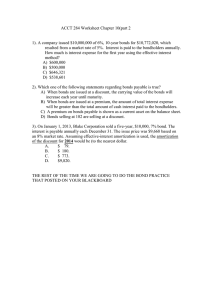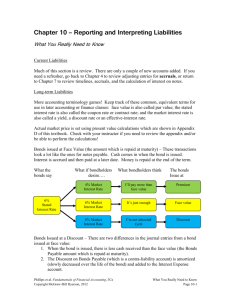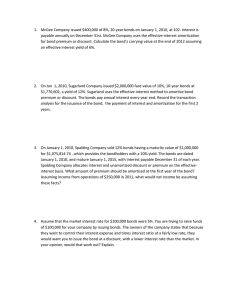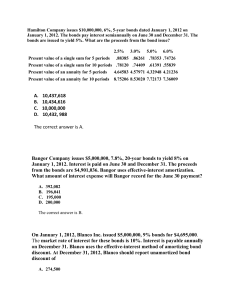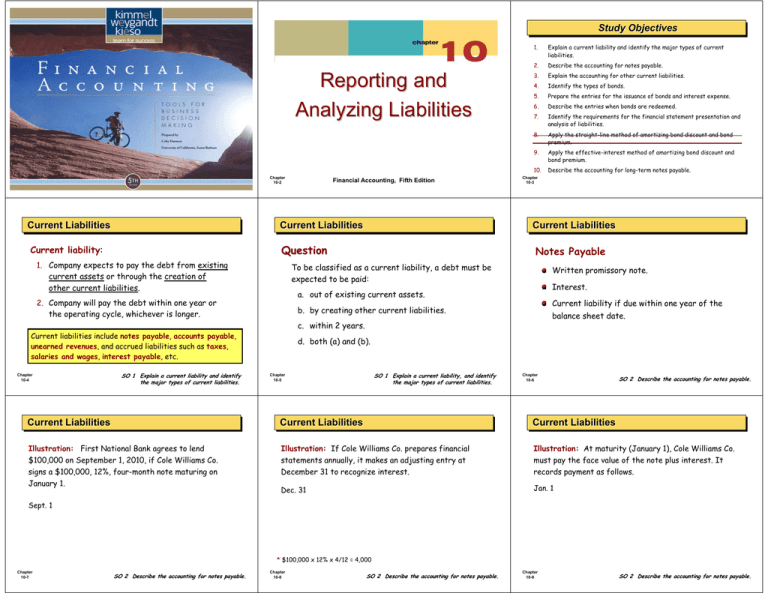
Study
Study Objectives
Objectives
Reporting and
Analyzing Liabilities
Chapter
10-1
Chapter
10-2
Current
Current Liabilities
Liabilities
Current
Current Liabilities
Liabilities
1. Company expects to pay the debt from existing
current assets or through the creation of
other current liabilities.
2.
Describe the accounting for notes payable.
3.
Explain the accounting for other current liabilities.
4.
Identify the types of bonds.
5.
Prepare the entries for the issuance of bonds and interest expense.
6.
Describe the entries when bonds are redeemed.
7.
Identify the requirements for the financial statement presentation and
analysis of liabilities.
8.
Apply the straight-line method of amortizing bond discount and bond
premium.
9.
Apply the effective-interest method of amortizing bond discount and
bond premium.
10.
Describe the accounting for long-term notes payable.
Chapter
10-3
Notes Payable
To be classified as a current liability, a debt must be
expected to be paid:
Written promissory note.
Interest.
a. out of existing current assets.
2. Company will pay the debt within one year or
the operating cycle, whichever is longer.
Current liability if due within one year of the
b. by creating other current liabilities.
balance sheet date.
c. within 2 years.
Current liabilities include notes payable, accounts payable,
unearned revenues, and accrued liabilities such as taxes,
salaries and wages, interest payable, etc.
SO 1 Explain a current liability and identify
the major types of current liabilities.
Explain a current liability and identify the major types of current
liabilities.
Current
Current Liabilities
Liabilities
Question
Current liability:
Chapter
10-4
Financial Accounting, Fifth Edition
1.
d. both (a) and (b).
SO 1 Explain a current liability, and identify
the major types of current liabilities.
Chapter
10-5
Chapter
10-6
SO 2 Describe the accounting for notes payable.
Current
Current Liabilities
Liabilities
Current
Current Liabilities
Liabilities
Current
Current Liabilities
Liabilities
Illustration: First National Bank agrees to lend
$100,000 on September 1, 2010, if Cole Williams Co.
signs a $100,000, 12%, four-month note maturing on
January 1.
Illustration: If Cole Williams Co. prepares financial
statements annually, it makes an adjusting entry at
December 31 to recognize interest.
Illustration: At maturity (January 1), Cole Williams Co.
must pay the face value of the note plus interest. It
records payment as follows.
Dec. 31
Jan. 1
Sept. 1
* $100,000 x 12% x 4/12 = 4,000
Chapter
10-7
SO 2 Describe the accounting for notes payable.
Chapter
10-8
SO 2 Describe the accounting for notes payable.
Chapter
10-9
SO 2 Describe the accounting for notes payable.
Current
Current Liabilities
Liabilities
Sales Tax Payable
Sales taxes are a percentage of the sales price.
Retailer collects tax from the customer.
Current
Current Liabilities
Liabilities
Current
Current Liabilities
Liabilities
Illustration: March 25, cash register readings for
Sometimes companies do not ring up sales taxes
separately on the cash register.
Cooley Grocery show sales of $10,000 and sales taxes of
$600 (sales tax rate of 6%), the journal entry is:
Illustration: Cooley Grocery rings up total receipts of
$10,600. Because the amount received from the sale is
equal to the sales price 100% plus 6% of sales,
(sales tax rate of 6%), the journal entry is:
Mar. 25
Retailer remits the collections to the state’s
department of revenue.
Chapter
10-10
SO 3 Explain the accounting for other current liabilities.
Mar. 25
Chapter
10-11
SO 3 Explain the accounting for other current liabilities.
Current
Current Liabilities
Liabilities
Current
Current Liabilities
Liabilities
Unearned Revenue
Illustration: Superior University sells 10,000 season
football tickets at $50 each for its five-game home
schedule. The entry for the sales of season tickets is:
Revenues that are received before the company
delivers goods or provides services.
1. Company debits Cash, and
credits a current liability
account (unearned revenue).
2. When the company earns
the revenue, it debits the
Unearned Revenue account,
and credits a revenue account.
Chapter
10-13
SO 3 Explain the accounting for other current liabilities.
Current
Current Liabilities
Liabilities
Payroll and Payroll Taxes Payable
The term “payroll” pertains to both:
Salaries - managerial, administrative, and sales
personnel (monthly or yearly rate).
Wages - store clerks, factory employees, and
manual laborers (rate per hour).
Determining the payroll involves computing three
amounts: (1) gross earnings, (2) payroll deductions,
and (3) net pay.
Chapter
10-16
SO 3 Explain the accounting for other current liabilities.
Chapter
10-12
SO 3 Explain the accounting for other current liabilities.
Current
Current Liabilities
Liabilities
Current Maturities of Long-Term Debt
Portion of long-term debt that comes due in the
current year.
Illustration: Wendy Construction issues a five-year, interest-bearing
After the first game, Superior records the earning of
revenue with the following entry.
$25,000 note on January 1, 2009. This note specifies that each January
1, starting January 1, 2010, Wendy should pay $5,000 of the note. When
the company prepares financial statements on December 31, 2009,
1. What amount should be reported as a current liability? _________
2. What amount should be reported as a long-term liability? _______
Chapter
10-14
SO 3 Explain the accounting for other current liabilities.
Current
Current Liabilities
Liabilities
SO 3 Explain the accounting for other current liabilities.
Current
Current Liabilities
Liabilities
Illustration: Assume Cargo Corporation records its
payroll for the week of March 7 as follows:
Mar. 7 Salaries and wages expense
FICA tax payable
Federal tax payable
State tax payable
Salaries and wages payable
Chapter
10-15
100,000
Payroll tax expense results from three taxes that
governmental agencies levy on employers.
These taxes are:
7,650
21,864
2,922
67,564
FICA tax
Federal unemployment tax
State unemployment tax
Record the payment of this payroll on March 7.
Mar. 7
Chapter
10-17
SO 3 Explain the accounting for other current liabilities.
Chapter
10-18
SO 3 Explain the accounting for other current liabilities.
Current
Current Liabilities
Liabilities
Illustration: Based on Cargo Corp.’s $100,000 payroll,
the company would record the employer’s expense and
liability for these payroll taxes as follows.
Payroll tax expense
Bond:
-Term Liabilities
Long
Bond: LongLong-Term
Liabilities
Question
Bonds are a form of interest-bearing notes payable
Employer payroll taxes do not include:
a. Federal unemployment taxes.
13,850
FICA tax payable
b. State unemployment taxes.
7,650
State unemployment tax payable
Federal unemployment tax payable
Chapter
10-19
Current
Current Liabilities
Liabilities
c. Federal income taxes.
800
SO 3 Explain the accounting for other current liabilities.
Bond:
-Term Liabilities
Long
Bond: LongLong-Term
Liabilities
Chapter
10-20
governmental agencies.
Sold in small denominations (usually $1,000 or
multiples of $1,000).
d. FICA taxes.
5,400
issued by corporations, universities, and
SO 3 Explain the accounting for other current liabilities.
Bond:
-Term Liabilities
Long
Bond: LongLong-Term
Liabilities
Chapter
10-21
SO 4 Identify the types of bonds.
Bond:
-Term Liabilities
Long
Bond: LongLong-Term
Liabilities
Issuer
Issuer of
of
Bonds
Bonds
Issuing Procedures
Types of Bonds
Illustration 10-3
Bond certificate
Secured
Maturity
Maturity
Date
Date
¾ Issued to the investor.
Unsecured
¾ Provides information such as the
Convertible
9 name of the company issuing bonds,
Callable
Contractual
Contractual
Interest
Interest
Rate
Rate
9 face value,
9 maturity date, and
9 contractual interest rate (stated rate).
Chapter
10-22
SO 4 Identify the types of bonds.
Bond:
-Term Liabilities
Long
Bond: LongLong-Term
Liabilities
Determining the Market Value of Bonds
Three factors that determine present value:
1. dollar amounts to be received,
2. length of time until the amounts are received, and
Chapter
10-23
SO 4 Identify the types of bonds.
Face
Face or
or
Par
Par Value
Value
Chapter
10-24
SO 4 Identify the types of bonds.
Bond:
-Term Liabilities
Long
Bond: LongLong-Term
Liabilities
Accounting
Accounting for
for Bond
Bond Issues
Issues
Illustration: Assume that Acropolis Company on January 1,
2010, issues $100,000 of 9% bonds, due in five years, with
interest payable annually at year-end.
A corporation records bond transactions when it
¾ issues or retires (buys back) bonds and
¾ when bondholders convert bonds into common stock.
Illustration 10-4
Time diagram
depicting cash
flows
Bonds may be issued at
¾ face value,
3. market rate of interest.
¾ below face value (discount), or
The process of finding the present value is
referred to as discounting the future amounts.
Chapter
10-25
SO 4 Identify the types of bonds.
Illustration 10-5
Computing the
market price of
bonds
Chapter
10-26
¾ above face value (premium).
Bond prices are quoted as a percentage of face value.
SO 4 Identify the types of bonds.
Chapter
10-27
SO 5 Prepare the entries for the issuance of bonds and interest expense.
Accounting
Accounting for
for Bond
Bond Issues
Issues
Issuing
Issuing Bonds
Bonds at
at Face
Face Value
Value
Question
Illustration: Devor Corporation issues 100, five-year, 10%,
$1,000 bonds dated January 1, 2010, at 100 (100% of face
value). The entry to record the sale is:
The rate of interest investors demand for loaning
funds to a corporation is the:
a. contractual interest rate.
b. face value rate.
Prepare the entry Devor would make to accrue interest on
December 31.
c. market interest rate.
d. stated interest rate.
Chapter
10-28
Chapter
10-29
Issuing
Issuing Bonds
Bonds at
at Face
Face Value
Value
SO 5 Prepare the entries for the issuance of bonds and interest expense.
Accounting
Accounting for
for Bond
Bond Issues
Issues
Market Interest
SO 5 Prepare the entries for the issuance of bonds and interest expense.
Accounting
Accounting for
for Bond
Bond Issues
Issues
Assume Contractual Rate of 10%
Prepare the entry Devor would make to pay the interest on
Jan. 1, 2011.
Chapter
10-30
Question
Karson Inc. issues 10-year bonds with a maturity value
of $200,000. If the bonds are issued at a premium,
this indicates that:
Bonds Sold At
8%
a. the contractual interest rate exceeds the market
interest rate.
10%
b. the market interest rate exceeds the contractual
interest rate.
12%
c. the contractual interest rate and the market
interest rate are the same.
d. no relationship exists between the two rates.
Chapter
10-31
SO 5 Prepare the entries for the issuance of bonds and interest expense.
Chapter
10-32
SO 5 Prepare the entries for the issuance of bonds and interest expense.
Issuing
Issuing Bonds
Bonds at
at aa Discount
Discount
Issuing
Issuing Bonds
Bonds at
at aa Discount
Discount
Illustration: Assume that on January 1, 2010, Candlestick
Inc. sells $100,000, five-year, 10% bonds at 98 (98% of face
value) with interest payable on January 1. The entry to
record the issuance is:
Statement Presentation
Chapter
10-33
SO 5 Prepare the entries for the issuance of bonds and interest expense.
Issuing
Issuing Bonds
Bonds at
at aa Discount
Discount
Question
Illustration 10-7
Statement presentation of
discount on bonds payable
Discount on Bonds Payable:
a. has a credit balance.
b. is a contra account.
c. is added to bonds payable on the balance sheet.
d. increases over the term of the bonds.
Illustration 10-8
Computation of total cost of
borrowing—bonds issued at
discount
Chapter
10-34
SO 5 Prepare the entries for the issuance of bonds and interest expense.
Chapter
10-35
SO 5 Prepare the entries for the issuance of bonds and interest expense.
Chapter
10-36
SO 5 Prepare the entries for the issuance of bonds and interest expense.
Issuing
Issuing Bonds
Bonds at
at aa Premium
Premium
Issuing
Issuing Bonds
Bonds at
at aa Premium
Premium
Illustration: Assume that the Candlestick Inc. bonds
previously described sell at 102 rather than at 98. The
entry to record the sale is:
Statement Presentation
Accounting
Accounting for
for Bond
Bond Retirements
Retirements
Redeeming Bonds at Maturity
Illustration 10-11
Statement presentation of
premium on bonds payable
Candlestick records the redemption of its bonds at maturity
as follows:
Illustration 10-12
Computation of total cost of
borrowing—bonds issued at
premium
Chapter
10-37
SO 5 Prepare the entries for the issuance of bonds and interest expense.
Accounting
Accounting for
for Bond
Bond Retirements
Retirements
Redeeming Bonds before Maturity
Chapter
10-38
SO 5 Prepare the entries for the issuance of bonds and interest expense.
Accounting
Accounting for
for Bond
Bond Retirements
Retirements
Question
Illustration: Assume at the end of the fourth period,
Candlestick Inc., having sold its bonds at a premium, retires
the bonds at 103 after paying the annual interest. Assume
that the carrying value of the bonds at the redemption
date is $100,400 (principal $100,000 and premium $400).
Candlestick records the redemption at the end of the fourth
interest period (January 1, 2014) as:
When bonds are redeemed before maturity, the gain
or loss on redemption is the difference between the
cash paid and the:
2. record the cash paid; and
3. recognize the gain or loss on redemption.
a. carrying value of the bonds.
b. face value of the bonds.
c. original selling price of the bonds.
The carrying value of the bonds is the face value of the bonds
less unamortized bond discount or plus unamortized bond premium
at the redemption date.
SO 6 Describe the entries when bonds are redeemed.
Accounting
Accounting for
for Bond
Bond Retirements
Retirements
d. maturity value of the bonds.
Chapter
10-41
SO 6 Describe the entries when bonds are redeemed.
Financial
Financial Statement
Statement Analysis
Analysis and
and Presentation
Presentation
Balance Sheet Presentation
Question
SO 6 Describe the entries when bonds are redeemed.
Accounting
Accounting for
for Bond
Bond Retirements
Retirements
1. eliminate the carrying value of the bonds;
Chapter
10-40
Chapter
10-39
Illustration 10-15
Chapter
10-42
SO 6 Describe the entries when bonds are redeemed.
Financial
Financial Statement
Statement Analysis
Analysis and
and Presentation
Presentation
Analysis
Illustration 10-16
When bonds are converted into common stock:
a. a gain or loss is recognized.
b. the carrying value of the bonds is transferred
to paid-in capital accounts.
c. the market price of the stock is considered in
the entry.
d. the market price of the bonds is transferred to
paid-in capital.
Chapter
10-43
SO 6 Describe the entries when bonds are redeemed.
Chapter
10-44
SO 7 Identify the requirements for the financial statement
presentation and analysis of liabilities.
Chapter
10-45
SO 7 Identify the requirements for the financial statement
presentation and analysis of liabilities.
Appendix 10B
Effective-Interest Amortization
Effective
Effective-Interest
Amortization
Effective-Interest Amortization
Effective
Effective-Interest
Amortization
Appendix 10B
Appendix 10B
Amortizing Bond Discount
Amortizing Bond Discount
Required steps:
Effective-Interest Amortization
Effective
Effective-Interest
Amortization
Illustration 10B-2
1. Compute the bond interest expense.
Illustration: Candlestick, Inc., sold $100,000, five-year,
2. Compute the bond interest paid or accrued.
10% bonds on January 1, 2010, for $98,000. The
effective-interest rate is 10.53% and interest is payable
3. Compute the amortization amount.
on Jan. 1 of each year. Prepare the bond discount
Illustration 10B-1
Chapter
10-46
amortization schedule.
SO 9 Apply the effectiveeffective-interest method of amortizing
bond discount and bond premium.
Chapter
10-47
Effective-Interest Amortization
Effective
Effective-Interest
Amortization
Appendix 10B
Effective-Interest Amortization
Effective
Effective-Interest
Amortization
Appendix 10B
Amortizing Bond Discount
Amortizing Bond Premium
Illustration: Candlestick, Inc. records the accrual of
interest and amortization of bond discount on Dec. 31,
as follows:
Illustration: Candlestick, Inc., sold $100,000, five-year,
Chapter
10-48
SO 9 Apply the effectiveeffective-interest method of amortizing
bond discount and bond premium.
Effective-Interest Amortization
Effective
Effective-Interest
Amortization
Appendix 10B
Amortizing Bond Premium
Illustration 10B-4
effective-interest rate is 9.48% and interest is payable on
Jan. 1 of each year. Prepare the bond premium
Dec. 31
Chapter
10-49
10% bonds on January 1, 2010, for $102,000. The
amortization schedule.
SO 9 Apply the effectiveeffective-interest method of amortizing
bond discount and bond premium.
Effective-Interest Amortization
Effective
Effective-Interest
Amortization
Appendix 10B
Amortizing Bond Premium
SO 9 Apply the effectiveeffective-interest method of amortizing
bond discount and bond premium.
Chapter
10-50
Long-Term Notes
Long
Long-Term
Notes Payable
Payable
Appendix 10C
Long-Term Notes Payable
Illustration: Candlestick, Inc. records the accrual of
interest and amortization of premium discount on Dec.
31, as follows:
May be secured by a mortgage that pledges title to
Dec. 31
of the loan. Payment consists of
specific assets as security for a loan.
Typically requires installment payments over the term
Chapter
10-51
SO 9 Apply the effectiveeffective-interest method of amortizing
bond discount and bond premium.
Long-Term Notes
Long
Long-Term
Notes Payable
Payable
Appendix 10C
Illustration: Porter Technology Inc. issues a $500,000,
12%, 20-year mortgage note on December 31, 2010. The
terms provide for semiannual installment payments of
$33,231.
Illustration 10C-1
1. interest on the unpaid balance and
2. a reduction of loan principal.
Companies initially record mortgage notes payable at
face value.
Chapter
10-52
SO 9 Apply the effectiveeffective-interest method of amortizing
bond discount and bond premium.
Chapter
10-53
SO 10 Describe the accounting for long-term notes payable.
Chapter
10-54
SO 10 Describe the accounting for long-term notes payable.
Long-Term Notes
Long
Long-Term
Notes Payable
Payable
Appendix 10C
Illustration: Porter Technology records the mortgage
loan and first installment payment as follows:
Long-Term Notes
Long
Long-Term
Notes Payable
Payable
Appendix 10C
Copyright
Copyright
Question
“Copyright © 2009 John Wiley & Sons, Inc. All rights reserved.
Reproduction or translation of this work beyond that permitted
Each payment on a mortgage note payable consists
of:
Dec. 31
in Section 117 of the 1976 United States Copyright Act without
the express written permission of the copyright owner is
a. interest on the original balance of the loan.
unlawful. Request for further information should be addressed
b. reduction of loan principal only.
Jun. 30
Chapter
10-55
SO 10 Describe the accounting for long-term notes payable.
Chapter
10-56
to the Permissions Department, John Wiley & Sons, Inc. The
c. interest on the original balance of the loan and
reduction of loan principal.
purchaser may make back-up copies for his/her own use only
d. interest on the unpaid balance of the loan and
reduction of loan principal.
responsibility for errors, omissions, or damages, caused by the
SO 10 Describe the accounting for long-term notes payable.
and not for distribution or resale. The Publisher assumes no
use of these programs or from the use of the information
contained herein.”
Chapter
10-57


